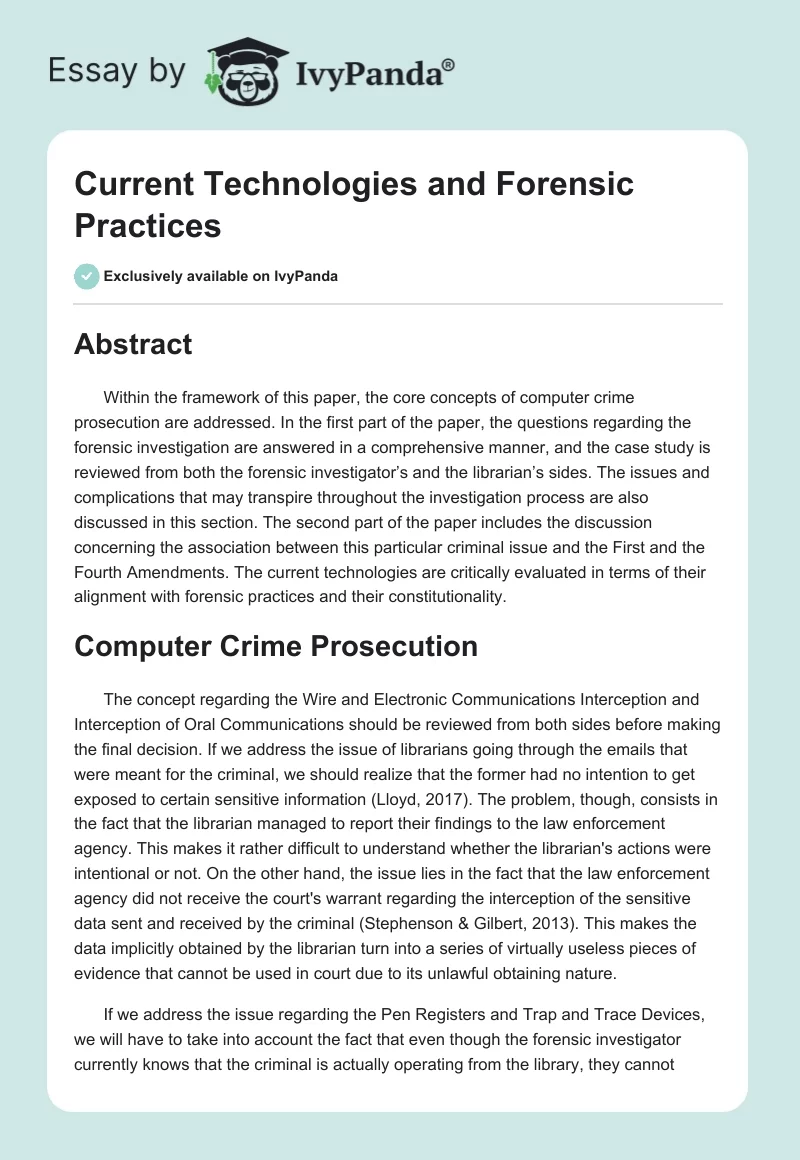Abstract
Within the framework of this paper, the core concepts of computer crime prosecution are addressed. In the first part of the paper, the questions regarding the forensic investigation are answered in a comprehensive manner, and the case study is reviewed from both the forensic investigator’s and the librarian’s sides. The issues and complications that may transpire throughout the investigation process are also discussed in this section. The second part of the paper includes the discussion concerning the association between this particular criminal issue and the First and the Fourth Amendments. The current technologies are critically evaluated in terms of their alignment with forensic practices and their constitutionality.
Computer Crime Prosecution
The concept regarding the Wire and Electronic Communications Interception and Interception of Oral Communications should be reviewed from both sides before making the final decision. If we address the issue of librarians going through the emails that were meant for the criminal, we should realize that the former had no intention to get exposed to certain sensitive information (Lloyd, 2017). The problem, though, consists in the fact that the librarian managed to report their findings to the law enforcement agency. This makes it rather difficult to understand whether the librarian’s actions were intentional or not. On the other hand, the issue lies in the fact that the law enforcement agency did not receive the court’s warrant regarding the interception of the sensitive data sent and received by the criminal (Stephenson & Gilbert, 2013). This makes the data implicitly obtained by the librarian turn into a series of virtually useless pieces of evidence that cannot be used in court due to its unlawful obtaining nature.
If we address the issue regarding the Pen Registers and Trap and Trace Devices, we will have to take into account the fact that even though the forensic investigator currently knows that the criminal is actually operating from the library, they cannot capture and sentence them because the former did not install any tracking software on the criminal’s computer. The latter remains under the protection of the law because installing registers and tracking devices is illegal under the existing circumstances (Conklin, White, Williams, Davis, & Cothren, 2016). There were no direct or twofold consents either. This limits the forensic investigator’s options to either fining or letting the librarian go or continuing to trace the criminal. Within the framework of the current case study, it seems to be reasonable to do both. There are several limitations that can be used to obtain the evidence, but its relevance and appropriateness will not be proven true in court.
The key factor that contributes to the complexity of this case study is the ethical problem that can be considered the cornerstone of this type of case. Even though the forensic investigator has the evidence that can be used to prosecute the criminal, they cannot use it because it (a) was obtained unintentionally (the librarian broke the law anyway) by the party that is not involved in the events and (b) the attempt to use this evidence in court will put both the investigator and the librarian at risk (Leman-Langlois, 2013). Therefore, the appropriateness of obtained evidence can be interpreted incorrectly within the framework of this case. Also, the investigator will have to take into account the civil rights of both the criminal and the librarian (Britz, 2013). To say the least, there is no correct answer that can be beneficial to all parties involved. Alternatively, the investigator will have the possibility to catch the criminal in the act throughout some other time. The type of case that is discussed throughout this paper is rather prevalent in the territory of the United States, but there is no unanimous decision that can mitigate the influence of limitations inherent in the statutes and ethical principles of the legislation.
Discussion
If we incorporate the First and the Fourth Amendments into this discussion, we will see that there is a necessity to review the case in the Supreme Court so that judges could evaluate the effectiveness of the Wiretap Act and the event of interception discussed above. The key idea is that the Fourth Amendment provides protection against unlawful tapping, but it works differently for various data sources and wave types. The First and the Fourth Amendments commonly protect the rights of the alleged victims but the case discussed within the framework of this paper brings a certain amount of ambiguity to the equation. The underlying concept here is the individual’s perception of privacy that is not contingent on any technological details (McMahon, 2014). Neither the First nor the Fourth Amendments were designed as an effective means of public protection and safety. Therefore, the current technologies may cause misinterpretation on the basis of governmental abuse of the evidence presented in the Amendments. The problem with the Amendments consists in the fact that they have to be constantly adjusted to the technological process, but there is no guarantee that it will positively impact the current state of affairs.
References
Britz, M. (2013). Computer forensics and cyber crime: An introduction. Boston, MA: Pearson.
Conklin, A., White, G. B., Williams, D., Davis, R., & Cothren, C. (2016). Principles of computer security. New York, NY: McGraw Hill.
Leman-Langlois, S. (2013). Technocrime, policing, and surveillance. New York, NY: Routledge.
Lloyd, I. J. (2017). Information technology law. New York, NY: Oxford University Press.
McMahon, R. J. (2014). Practical handbook for professional investigators. Boca Raton, FL: CRC Press, Taylor & Francis Group.
Stephenson, P., & Gilbert, K. (2013). Investigating computer-related crime (2nd ed.). Boca Raton, FL: Taylor & Francis.


